

Fountain pen ink possesses a well-dispersed nature and a relatively large specific surface area of carbon nanoparticles. In the present study, fountain pen ink was systematically studied and developed as cost-efficient counter electrodes (CEs) for planar dye-sensitized solar cells and fiber-shaped DSSCs (FDSSCs), which showed power conversion efficiencies above 6% under AM1.5G (100 mW cm-2). For ink-based planar solar cells, Electrochemical impedance spectroscopy (EIS) confirmed that ink CE had a slightly lower charge-transfer resistance than platinum CE. EIS also proved that adding TiO2 nanoparticles into ink could reduce the device’s series resistance and the diffusion impedance of electrolyte through electrode pores. For ink-based FDSSCs, the effects of film thickness, light intensities, and a comparative research of CE catalytic activities toward various electrolytes were discussed.
